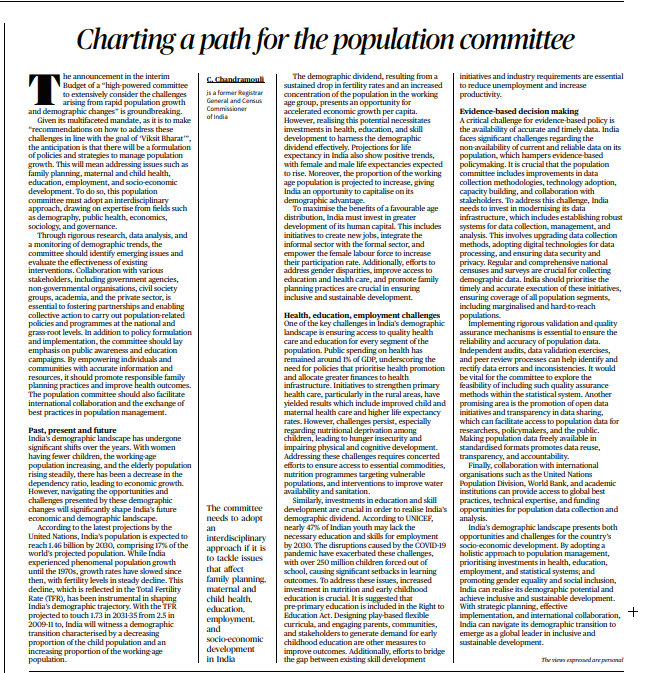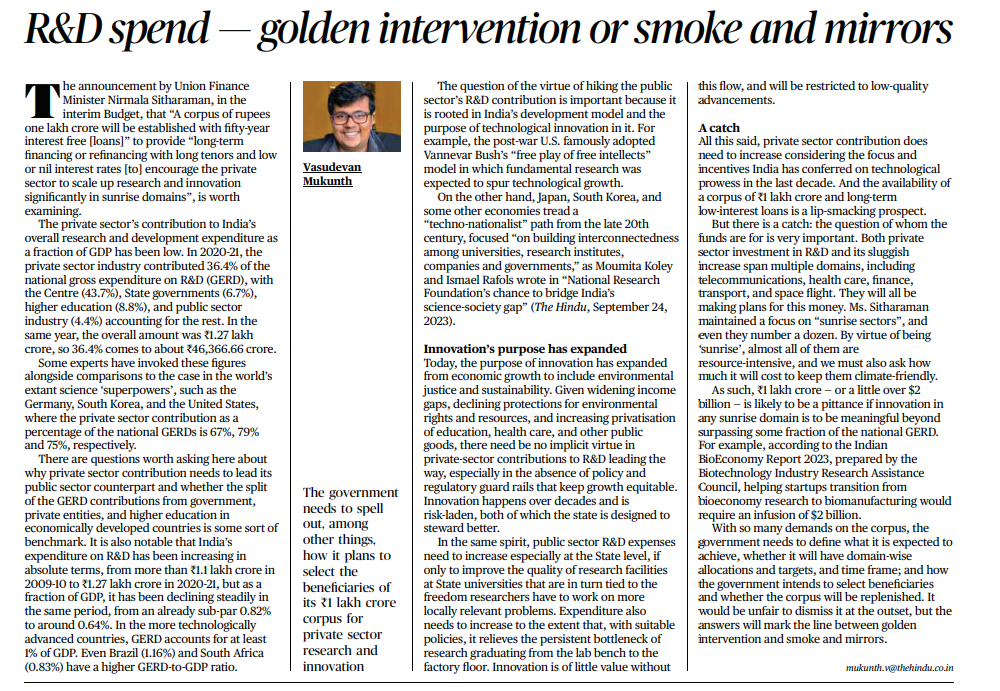Introduction: Addressing Population Growth Challenges
The announcement in the interim Budget of a “high-powered committee to extensively consider the challenges arising from rapid population growth and demographic changes” marks a significant step towards addressing India’s population dynamics.
The multifaceted mandate of the committee, aimed at achieving ‘Viksit Bharat’, suggests a comprehensive approach to formulate policies and strategies to manage population growth.
This editorial summary delves into the implications, challenges, and opportunities presented by India’s demographic landscape, emphasizing the importance of evidence-based decision-making and international collaboration.
Understanding India’s Demographic Landscape
- India’s demographic landscape has witnessed significant shifts over the years, characterized by declining fertility rates, an increasing working-age population, and a rising elderly population.
- Despite a decrease in the dependency ratio, India is poised to become the world’s most populous country by 2030, with projections indicating a population of 1.46 billion.
- The demographic dividend, resulting from a declining fertility rate, presents both opportunities and challenges for India’s economic growth and development.
Maximizing the Demographic Dividend
- To harness the demographic dividend effectively, India must invest in health, education, and skill development.
- This entails creating new jobs, integrating the informal sector, empowering the female labor force, and addressing gender disparities.
- By prioritizing investments in human capital and promoting inclusive development, India can capitalize on its demographic advantage to accelerate economic growth.
Challenges in Health, Education, and Employment
- Access to quality healthcare and education remains a key challenge in India’s demographic landscape.
- With public spending on health around 1% of GDP, there is a need for policies that prioritize health promotion and allocate greater finances to health infrastructure.
- Similarly, investments in education and skill development are crucial to ensuring that the youth are equipped with the necessary knowledge and skills for employment opportunities.
Evidence-Based Decision Making
- A critical challenge for policymaking is the availability of accurate and timely data.
- India faces obstacles in data collection, management, and analysis, hampering evidence-based policymaking.
- To address this challenge, the population committee must focus on improving data collection methodologies, technology adoption, and capacity building.
- Collaboration with international organizations and academic institutions can provide access to technical expertise and funding opportunities for population data collection and analysis.
Conclusion: Realizing India’s Demographic Potential
- India’s demographic landscape presents both opportunities and challenges for socio-economic development.
- By adopting a holistic approach to population management, prioritizing investments in health, education, employment, and statistical systems, and promoting gender equality and social inclusion, India can realize its demographic potential and achieve inclusive and sustainable development.
Strategic planning, effective implementation, and international collaboration are key to navigating India’s demographic transition and emerging as a global leader in inclusive development.
Introduction
Union Finance Minister Nirmala Sitharaman announced the establishment of a ₹1 lakh crore corpus with fifty-year interest-free loans to encourage private sector investment in research and innovation, particularly in sunrise domains.
Private Sector Contribution in R&D
- Private sector contribution to India’s R&D expenditure has been low, accounting for 36.4% of the national gross expenditure on R&D in 2020-21.
- Comparisons with global science leaders like Germany, South Korea, and the United States highlight the disparity, where private sector contributions are significantly higher.
Challenges and Questions
- The need for private sector dominance in R&D and whether international benchmarks should guide India’s R&D expenditure distribution.
- Despite an increase in R&D spending in absolute terms, India’s R&D expenditure as a fraction of GDP has been declining, lagging behind technologically advanced nations.
Development Models and Innovation
- Examining different models like the ‘free play of free intellects’ adopted by the U.S. and the ‘techno-nationalist’ approach of Japan and South Korea.
- The evolving purpose of innovation from economic growth to encompass environmental justice and sustainability, questioning the implicit virtue of private sector leadership in R&D.
Role of the State and Public Sector
- Advocating for increased public sector R&D expenditure, especially at the state level, to improve research facilities and address locally relevant issues.
- Emphasizing the importance of policies facilitating the transition of research from the lab to practical applications.
Prospects and Concerns
- Acknowledging the potential of the ₹1 lakh crore corpus but raising concerns about its allocation, efficacy, and impact.
- The importance of defining objectives, domain-wise allocations, selection criteria, and replenishment plans to ensure meaningful outcomes.
Conclusion
While the corpus presents an opportunity for boosting innovation, careful planning, and transparency in allocation and utilization are essential to avoid inefficiencies and ensure impactful outcomes.
This editorial emphasizes the complexity and significance of private sector involvement in R&D, highlighting the need for a nuanced approach that balances various stakeholders’ interests and aligns with India’s development goals.
Introduction
- The editorial delves into the relationship between management education, commercial interests, and the broader scope of scholarly pursuits within educational institutions.
- It critiques the prevalent focus on commercial aspects and highlights the challenges in fostering scholastic interests in management education.
Diverse Forms of Business Management
- The editorial elucidates that while traditional business management primarily emphasizes commercial optimization, there exist various forms of business beyond manufacturing, such as education, financial exchanges, and news dissemination.
- This diversity necessitates specialized education, which conventional MBA programs may struggle to accommodate adequately.
Challenges in Specialization
- Super specialization in management education faces hurdles due to the vast array of business sectors and the lack of comprehensive curricula.
- Limited reading materials and research resources hinder the development of specialized areas like Agriculture or Research & Development within management education.
Commercialization vs. Intellectual Feasibility
- A tension arises between commercial relevance and intellectual feasibility, posing a dilemma for educational institutions.
- While commercial activities garner more attention and resources, scholastic pursuits suffer, undermining the essence of academic endeavors.
Funding and Research Orientation
- Sustaining scholarly focus demands adequate funds and a research-oriented environment.
- However, securing funding for non-commercial endeavors remains challenging, as quantifying the returns on investment proves elusive.
Global Perspective on Education
- The passage critiques the notion of global education, asserting that rankings predominantly feature English-speaking institutions, overlooking non-English speaking universities.
- This bias perpetuates a misconception about what constitutes truly global education.
Challenges in Education Industry
- Education, viewed as an industry, is portrayed as immature, with significant room for growth and improvement.
- Recognizing and addressing deficiencies in education require widespread acknowledgment and concerted efforts.
Conclusion
The excerpt underscores the need for a balanced approach in management education that reconciles commercial interests with scholarly pursuits.
It highlights the challenges inherent in diversifying education and calls for a reevaluation of global education standards.
Ultimately, the passage emphasizes the long-term value of education beyond simplistic generalizations and advocates for a more nuanced understanding of its complexities.




